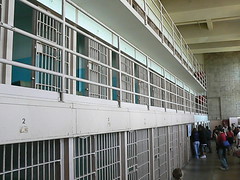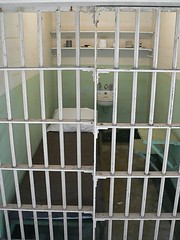 Today the HE Blog takes you into the inner works of the National Juvenile Justice Network. Today we are interviewing Benjamin Chambers, the NJJN’s Communications Specialist. A professional writer for over 20 years, he also has over ten years of experience in the field of juvenile justice. So, without further ado, here is Ben!
Today the HE Blog takes you into the inner works of the National Juvenile Justice Network. Today we are interviewing Benjamin Chambers, the NJJN’s Communications Specialist. A professional writer for over 20 years, he also has over ten years of experience in the field of juvenile justice. So, without further ado, here is Ben!
HE: Thanks for joining us on the HE blog! Would you be kind enough to share with our readers a thumbnail view of what your organization’s mission is?
BC: We lead a movement of state-based organizations and coalitions focused on reforming the juvenile justice system at all levels to make it fair and age-appropriate for youth in trouble with the law.
HE: I get the impression that the NJJN acts as a bit of a meta-organization, an overarching group of groups. Is that an accurate perception and what made you decide to adopt such a strategy?
BC: Yes, that’s accurate. We were actually created in 2002 by 11 organizations that felt they could be more effective if they had help coordinating their efforts, sharing news and resources, and advancing a consistent national strategy.
HE: You have member organizations in 33 states now. How long did it take to build the network to that point?
.
BC: About seven years. We find that reformers are eager to connect with their colleagues and peers – being an advocate for teens can be lonely work, though rewarding. And they can see the benefits of sharing knowledge and experience with others working to help kids in trouble with the law.
HE: Have you seen any recent acceleration in the process as more news stories about our failing juvenile justice system make it to the evening news?
BC: I don’t think the media has been the biggest driver behind our membership growth, though news stories have done a lot to educate people about the many ways the justice system fails to keep our kids safe, or help them be successful — and that there are better options, backed by research.
But our primary membership is made up of organizations that subscribe to our nine principles of reform, and which work on multiple issues having to do with youth in trouble with the law. In some states there’s not yet an organization that can meet those criteria, which is why we recently created a new category for “affiliates”.
HE: One of the interesting projects started by your group is the Youth Justice Leadership Institute. What would you say are the greatest successes it has seen so far?
BC: We’re excited about it, too, and we’re incredibly grateful to our funder, the Public Welfare Foundation, for seeing the value in what we’re trying to do. As you know, the Institute’s mission is to develop a larger base of folks who are well-prepared to promote reforms for youth in trouble with the law who reflect the communities most affected by the the juvenile justice system — we’re making a special effort to cultivate and support leaders of color.
We’re in the middle of our pilot year now; we have ten fellows engaged in trainings on things like the federal Juvenile Justice and Delinquency Prevention Act, age-appropriate services and using communications to change policy. They’re an accomplished group of professionals in their own right, and we can’t wait to see what they’ll accomplish down the road.
Right now, each one has been matched with one to three mentors in the field, and they’re all working on individual advocacy projects. It’s safe to say that all of them feel more engaged and energized about juvenile justice reform, and more connected to the larger movement, than they did when they started. In fact, in the next few weeks, I hope to post some video interviews with them from our July training session, so you can hear from them directly.
We’re planning now for our 2012 Institute, and should be putting out a call for nominations soon.
HE: What about some of the most important lessons learned as it has evolved?
BC: Although we obviously knew there was some need for this sort of training, we were pleasantly surprised by the great desire for it among newer advocates and activists. We didn’t do a huge amount of outreach for our 2011 Institute, and we got quite a few applications from people who wanted intensive training in this fairly specialized field. So that was one important lesson.
Second, we’ve found that one of the most important skills young leaders need to develop is figuring out how to balance all the demands on them, in all areas of their lives, not just their work. Simply learning to apply the old lesson, “It’s not a race, it’s a marathon,” is an important step for people to take if they’re going to be successful leaders.
Third, when we put out the call for applications, we really didn’t know what to expect. We learned that there’s a good-sized pool of folks out there who have huge potential for leadership.
HE: Your Fiscal Policy Center is doing good work in attempting the change things at the governmental level. What sort of tools are you using and how do you see these efforts expanding in the future?
BC: The Fiscal Policy Center is another project we’re excited about. Basically, state-level groups are finding it difficult to promote new reforms to the juvenile justice system — or prevent reversals of past victories — because of the state budget crunch. This is ironic, since it would be much cheaper and far more effective if we stopped spending so much on locking kids up and shifted those monies to providing treatment and other services to kids in their own communities.
We actually published a short primer on this last year, called “The Real Costs and Benefits of Change: Finding Opportunities for Reform During Difficult Fiscal Times.” Another brief publication people should find helpful in this regard is “Bringing Youth Home: A National Movement to Increase Public Safety, Rehabilitate Youth, and Save Money.”
So the goal of the Fiscal Policy Center is help our state-level members learn more about how state budget processes work and where the funding is going (or could go), and put together compelling arguments for reform for youth in trouble with the law based on sound fiscal knowledge and effective communications strategies.
To do that, we’re providing online toolkits and resources for members and reformers through our Fiscal Policy Resource Center. (That’s also a work in progress – we’ll be adding a lot to it in the coming months.) We’re also doing webinars, in-person trainings, and in-depth technical assistance for our members that focus on both fiscal knowledge and effective communications.
As with the Youth Justice Leadership Institute, we’ve very grateful to the John D. and Catherine T. MacArthur Foundation, Open Society Foundations, Public Welfare Foundation, and Tow Foundation for having the vision to help us meet this need in the field.
HE: Do you find that people are often surprised to discover that rehabilitation is vastly cheaper than incarceration? Do your efforts often encounter incredulous reactions based on this reasoning?
BC: Yes, I think people are often surprised to learn that. And frankly, it can be hard for people to care, when we have programs like “Beyond ‘Scared Straight'” promoting programs that are damaging and ineffective, but which — through the magic of television — *seem* to be effective. We need to promote more accurate depictions of young people, emphasizing their ability to change and the fact that interventions that don’t televise well — like therapy — are actually better for our kids and better for our communities.
HE: Your website speaks of “rightsizing,” the justice systems across the states. In this context that means reducing the size of institutions to an appropriate level but substituting proven community based measures for incarceration where possible. Where would you say you have experienced the most success with this? And the least?
BC: Actually, we’re in the middle of an incredible period of success with right-sizing juvenile justice nationally. The fiscal crisis helps, but research is also turning the tide. You can learn a lot more about what specific states have done on this score in the publication I mentioned above, “Bringing Youth Home: A National Movement to Increase Public Safety, Rehabilitate Youth, and Save Money.”
The real key going forward will be making sure that states don’t reverse these advances and start locking kids up again once the economy improves. That’s one reason why it’s critically important that advocates avoid relying solely on economic arguments to justify reducing the number of kids who are locked up. That’s not hard, really, since the research is clear that kids are actually harmed by being locked up — they’re more likely to commit new crimes then they get out, and that’s not good for anyone.
HE: Thanks a lot Ben! We appreciate your taking the time to speak with us and look forward to touching base with you in the future as things evolve!
Benjamin Chambers is NJJN’s Communications Specialist. He has been writing professionally for over 20 years, and has over ten years of experience in the field of juvenile justice.
Between 2000 and 2007, he worked for the Multnomah County Department of Community Justice in Portland Oregon, where he served on the juvenile management team and directed the local Reclaiming Futures project, an initiative designed to improve alcohol and drug treatment services for teenagers caught in the cycle of drugs, alcohol, and crime.
After a stint at the Reclaiming Futures national program office at Portland State University, he was hired by Prichard Communications in 2008 to launch and edit the Reclaiming Futures blog and social media channels, which he built into premier venues for juvenile justice news and resources.
chambers@juvjustice.org | 202-467-0864 x556

 Two huge reasons to support reform of our justice system, particular the juvenile segments of it. First, rehabilitation is cheaper and more effective. Second, the conditions within the American penal system and its adjuncts are often violent and deplorable.
Two huge reasons to support reform of our justice system, particular the juvenile segments of it. First, rehabilitation is cheaper and more effective. Second, the conditions within the American penal system and its adjuncts are often violent and deplorable.







 The economic side of the penal system is something we look at a lot. In so many cases, the return of preventative programs vastly outstrips the return we see from imprisoning people. Our documentary is titled
The economic side of the penal system is something we look at a lot. In so many cases, the return of preventative programs vastly outstrips the return we see from imprisoning people. Our documentary is titled 







